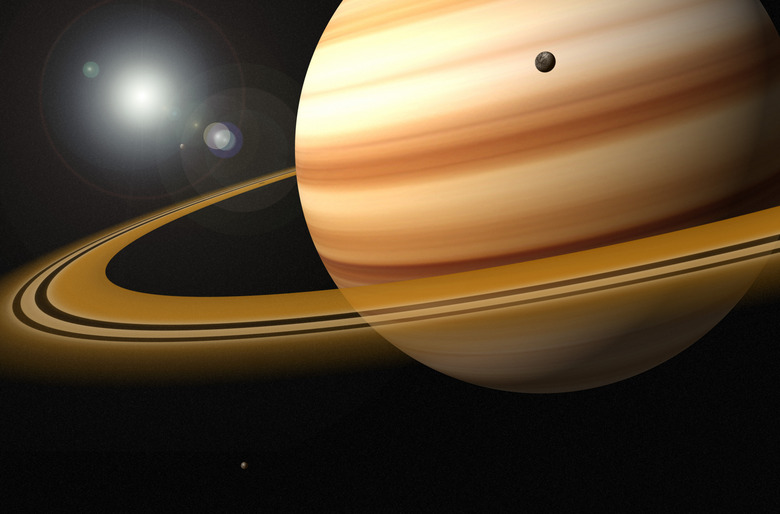What Is Saturn's Orbit In Earth Days?
Long before 1610 when Galileo turned his telescope on the sixth planet in the solar system, the Romans watched Saturn wandering across the sky and named the planet after their god of agriculture. Compared to Earth, Saturn moves more slowly around the sun but rotates on its axis much more quickly. Until the Voyager and Cassini spacecraft revealed rings around Jupiter, Uranus and Neptune, scientists thought Saturn's distinctive rings were unique.
The Saturnian Year
The Saturnian Year
Saturn moves approximately 22,000 mph in its revolution around the sun. This is about one-third the speed that Earth travels in its orbit. Saturn also has much farther to go to complete its annual journey around the sun. The longer axis of its elliptical orbit is almost 900 million miles, about 10 times that of Earth's orbit. The length of the Saturnian year, the time it takes for the planet to make one full revolution around the sun, is 29-1/2 Earth years or 10,755 Earth days.
The Saturnian Day
The Saturnian Day
Saturn might move slowly in its orbit, but it spins on its axis much more quickly than Earth, completing one rotation in a little less than half an Earth day. Because Saturn's diameter is nearly 10 time greater than Earth's, any point on Saturn's equator moves nearly 20 times faster than a corresponding point on Earth's equator. This rapid rotation gives Saturn a slightly oblong shape, which flattens at the poles and widens at the equator. When revising estimates of Saturn's rotational rate in 2004, scientists emphasized that it is only an estimate, because the surface isn't solid and has no fixed points.
Rings and Moons
Rings and Moons
Perhaps more than any other planet, Saturn represents a world unto itself. It has 62 moons, more than any other planet. Although many of these moons are no more than one or two miles across, others are larger than Earth's moon. The largest, Titan, is the second-largest moon in the solar system; it has an atmosphere. The presence of so many moons, especially the small ones, might explain the distinctive rings around Saturn. The rings might be all that's left of a host of such bodies that orbited the planet in the past.
The Cassini-Huygens Spacecraft
The Cassini-Huygens Spacecraft
Much of our detailed knowledge of the Saturnian system comes from the Cassini-Huygens spacecraft launched in 1997. It entered orbit on December 25, 2004 and has been sending data back ever since. Among the data is a series of radio emissions received from the surface of the planet. These signals enabled scientists to more accurately estimate the planet's rate of rotation. Shortly after entering orbit, Cassini released the Huygens probe, which landed on Titan on January 14, 2005. The spacecraft revealed the existence of lakes of methane and ethane gas as large as the Great Lakes on Earth.
Cite This Article
MLA
Deziel, Chris. "What Is Saturn's Orbit In Earth Days?" sciencing.com, https://www.sciencing.com/saturns-orbit-earth-days-2340/. 24 April 2017.
APA
Deziel, Chris. (2017, April 24). What Is Saturn's Orbit In Earth Days?. sciencing.com. Retrieved from https://www.sciencing.com/saturns-orbit-earth-days-2340/
Chicago
Deziel, Chris. What Is Saturn's Orbit In Earth Days? last modified August 30, 2022. https://www.sciencing.com/saturns-orbit-earth-days-2340/
